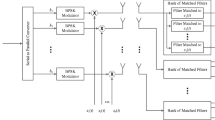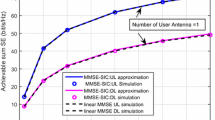Abstract
For multiple-input multiple-output (MIMO) communication systems, the zero-forcing (ZF) receiver has attracted great research interest in recent years. The purpose of this work is to analyze the effect of channel estimation error on the performance of the MIMO-ZF receiver over spatially correlated Rayleigh fading channels. Unlike previous works, where the channel is assumed with transmit correlation but without receiver correlation, we treat the fully correlated channel cases. Furthermore, we assume that the channel estimation error is a Gaussian and correlated matrix. The distribution of the post-processing signal-to-noise ratios is approximated. An approximation of the average bit error rate (BER) is derived and compared to Monte Carlo simulation results. The proposed BER expression takes into consideration that the post-processing noise in not Gaussian. Numerical results show an excellent agreement between the analytical approximation and Monte Carlo simulation curves.







Similar content being viewed by others
Explore related subjects
Discover the latest articles and news from researchers in related subjects, suggested using machine learning.Notes
Note that \({\varvec{R}}_{ {{\varvec{H}}}, {{\varvec{H}}}}={\mathbb{E}}[ {\varvec{H}} {\varvec{H}}^H ] \) denotes the covariance of the channel matrix and does not correspond to the conventional definition of covariance \({\mathbb{E}}[ {\text{vec}} ( {\varvec{H}}) {\text{vec}} ( {\varvec{H}} )^H] \).
Since \(({\varvec{A}}\otimes {\varvec{B}})^H={\varvec{A}}^H \otimes {\varvec{B}}^H\).
References
Winters, J. H., Salz, J., & Gitlin, R. D. (1994). The impact of antenna diversity on the capacity of wireless communication systems. IEEE Transactions on Communications, 42(234), 1740–1751.
Foschini, G. J., & Gans, M. J. (1998). On limits of wireless communications in a fading environment when using multiple antennas. Wireless Personal Communications, 6, 311–335.
Bjerke, B. A., & Proakis, J. G. (1999). Multiple-antenna diversity techniques for transmission over fading channels. In Proceedings of IEEE wireless communications and networking conference (pp. 1038–1042).
Foschini, G. J. (1996). Layered space–time architecture for wireless communication in a fading environment when using multi-element antennas. Bell Labs Technical Journal, 1, 41–59.
Wolniansky, P. W., Foschini, G. J., Golden, G. D., & Valenzuela, R. A. (1998). V-BLAST: An architecture for realizing very high data rates over the rich-scattering wireless channel. In Proceedings of international symposium on signals, systems, and electronics (pp. 295–300).
Nobandegani, K. S., & Azmi, P. (2010). A study of the extreme effects of fading correlation and the impact of imperfect MMSE channel estimation on the performance of SIMO zero-forcing receivers and on the capacity-maximizing strategy in SIMO links. IEEE Transactions on Vehicular Technology, 59(3), 1294–1306.
Nobandegani, K. S., & Azmi, P. (2010). Effects of inaccurate training-based minimum mean square error channel estimation on the performance of multiple input-multiple output Vertical Bell Laboratories space–time zero-forcing receivers. IET Communications, 4(6), 663–674.
Siriteanu, C., Miyanaga, Y., Blostein, S. D., Kuriki, S., & Shi, X. (2012). MIMO zero-forcing detection analysis for correlated and estimated rician fading. IEEE Transactions on Vehicular Technology, 61(7), 3087–3099.
Wang, C., Au, E. K. S., Murch, R. D., Mow, W. H., Cheng, R. S., & Lau, V. (2007). On the performance of the MIMO zero-forcing receiver in the presence of channel estimation error. IEEE Transactions on Wireless Communications, 6(3), 805–810.
Cavers, J. (1991). An analysis of pilot symbol assisted modulation for rayleigh fading channels. IEEE Transactions on Vehicular Technology, 40(4), 686–696.
Ding, M., & Blostein, S. D. (2010). Maximum mutual information design for MIMO systems with imperfect channel knowledge. IEEE Transactions on Information Theory, 56(10), 4793–4801.
Garg, P., Mallik, R. K., & Gupta, H. M. (2005). Performance analysis of space–time coding with imperfect channel estimation. IEEE Transactions on Wireless Communications, 4(1), 257–265.
Ho, P. K. M., Yar, K. P., & Kam, P. Y. (2009). Cutoff rate of MIMO systems in rayleigh fading channels with imperfect CSIR and finite frame error probability. EEE Transactions on Vehicular Technology, 58(7), 3292–3300.
Medard, M. (2000). The effect upon channel capacity in wireless communications of perfect and imperfect knowledge of the channel. IEEE Transactions on Information Theory, 46(3), 933–946.
Musavian, L., Nakhai, M. R., Dohler, M., & Aghvami, A. H. (2007). Effect of channel uncertainty on the mutual information of MIMO fading channels. EEE Transactions on Vehicular Technology, 56(5), 2798–2806.
Gore, D. A., Heath, R. W. J., & Paulraj, A. J. (2002). Transmit selection in spatial multiplexing systems. IEEE Communications Letters, 6(11), 491–493.
Li, X., & Nie, Z. (2004). Performance losses in V-BLAST due to correlation. IEEE Antennas Wireless Propagation Letters, 3, 291–294.
Telatar, I. E. (1999). Capacity of multi-antenna Gaussian channels. European Transactions on Telecommunications, 10, 585–595.
Shiu, D. S., Foschini, G. J., Gans, M. J., & Kahn, J. M. (2000). Fading correlation and its effect on the capacity of multielement antenna systems. IEEE Transactions on Communications, 48(3), 502–513.
Kang, M., & Alouini, M. S. (2006). Capacity of correlated MIMO Rayleigh channels. IEEE Transactions on Wireless Communications, 5, 143–155.
Loyka, S. L. (2001). Channel capacity of MIMO architecture using the exponential correlation matrix. IEEE Communication Letters, 5(9), 369–371.
Chiani, M., Win, M. Z., & Zanella, A. (2003). On the capacity of spatially correlated MIMO Rayleigh-fading channels. IEEE Transactions on Information Theory, 49(10), 2363–2371.
McKay, M. R., & Collings, I. B. (2007). Error performance of MIMO-BICM with zero-forcing receivers in spatially-correlated Rayleigh channels. IEEE Transactions on Wireless Communications, 6(3), 787–792.
Thian, B. S., & Goldsmith, A. (2010). Decoding for MIMO systems with imperfect channel state information. In Proceedings of IEEE global telecommunication conference.
Dangl, M. A., Sgraja, C., & Lindner, J. (2007). An improved block equalization scheme for uncertain channel estimation. IEEE Transactions on Wireless Communications, 6(1), 146–156.
Kermoal, J. P., Schumacher, L., Pedersen, K. I., Mogensen, P. E., & Frederiksen, F. (2002). A stochastic MIMO radio channel model with experimental validation. IEEE Journal on Selected Areas in Communications, 20(6), 1211–1226.
Taricco, G., & Biglieri, E. (2005). Space–time decoding with imperfect channel estimation. IEEE Transactions on Wireless Communications, 4(4), 1874–1888.
Dall’Anese, E., Assalini, A., & Pupolin, S. (2009). On the effect of imperfect channel estimation upon the capacity of correlated MIMO fading channels. In Proceedings of IEEE vehicular technology conference.
Xu, R., & Lau, F. C. M. (2006). Performance analysis for MIMO systems using zero forcing detector over fading channels. IEE Proceedings Communications, 153(1), 74–80.
Saleh, H., & Hamouda, W. (2009). Performance of zero-forcing detectors over MIMO flat-correlated Ricean fading channels. IET Communications, 3(1), 10–16.
Kiessling, M., & Speidel, J. (2003). Analytical performance of MIMO zero-forcing receivers in correlated Rayleigh fading environments. In Proceedings of 4th IEEE workshop signal processing advances in wireless communications SPAWC 2003 (pp. 383–387).
Abadir, K. M., & Magnus, J. R. (2005). Matrix algebra (econometric exercises). Cambridge: Cambridge University Press.
Goldsmith, A. (2005). Wireless Communications. Cambridge: Cambridge University Press.
Author information
Authors and Affiliations
Corresponding author
Appendix: Proof of the First Inequality in (32)
Appendix: Proof of the First Inequality in (32)
The conditioned covariance of the virtual noise is given by (31)
Since \({\varvec{U}}_s\) is a unitary matrix, we have \(({\varvec{x}}_i' \otimes {\varvec{H}}^{\dag } ) {\varvec{U}}_s \sim ({\varvec{x}}_i' \otimes {\varvec{H}}^{\dag } )\). Thus, we can write
We recall that \({\varvec{D}}_s \) is a diagonal matrix whose elements satisfy \(\left[ {\varvec{D}}_s \right] _{ii} \ge \lambda _{\text{min}}^s\). Hence, we have the first inequality of (32)
Rights and permissions
About this article
Cite this article
Ammari, M.L., Fortier, P. On the Analysis of MIMO-ZF Receiver Over Fully Correlated MIMO Rayleigh Fading with LMMSE Channel Estimation. Wireless Pers Commun 85, 1025–1042 (2015). https://doi.org/10.1007/s11277-015-2823-2
Published:
Issue Date:
DOI: https://doi.org/10.1007/s11277-015-2823-2




